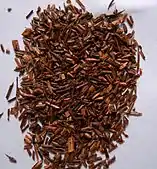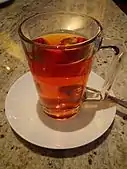rooibos
See also: Rooibos
English
WOTD – 24 September 2016
Dried and cut rooibos ready for brewing
A glass of rooibos tea
The rooibos plant (Aspalathus linearis)
Alternative forms
Pronunciation
- (Received Pronunciation, General South African) IPA(key): /ˈɹɔɪ.bɒs/
Audio (US) (file) - (General American) IPA(key): /ˈɹɔɪ.bɔs/
- (Canada) IPA(key): /ˈɹɔɪ.bəs/
- Hyphenation: rooi‧bos
Noun
rooibos (uncountable)
- (South Africa) A shrub (Aspalathus linearis) from which a tisane (herbal tea) is made.
- 1980, Panoramic South Africa, Johannesburg: Central News Agency, →ISBN, page 41:
- The air is aromatic with buchu (Rutaceae), pines, rooibos (Aspalathus linearis), and, of course, the cedars for which these mountains are named.
- 2006, Karena Du Plessis; Vanessa Cowling, West Coast: Landscape, People, Food, Texture, Cape Town: Struik, →ISBN:
- Love it or hate it, rooibos (Aspalathus linearis) is as much a part of this region as rock art, velskoen and stunning spring flowers.
- 2010, Daniel F. Robinson, “Non-patent Biopiracy Cases”, in Confronting Biopiracy: Challenges, Cases and International Debates, London; Washington, D.C.: Earthscan, →ISBN, page 89:
- Rooibos (Aspalathus linearis, Fabaceae) is a plant that is indigenous only to the Cedarburg Mountain Range near Cape Town, South Africa. Wilson (2005, p140) notes that the mountain-dwelling people of the Khoikhoi were the first to use rooibos as a tea and, had it not been for them, rooibos would probably simply have remained an unutilized bush. The name ‘rooibos’ is an Afrikaans word meaning red bush for which the plant has been commonly known since at least the 1960s and probably back to the 1940s, and which is perceived as part of the country's heritage (Cheney and Scholtz, 1963).
-
- The tisane (herbal tea) made from this plant.
- 1909 October 28, “Heatlie Bros. and Others vs. Hartley”, in “Cape Times” Law Reports: A Record of Every Matter Disposed of in the Supreme Court, volume 19, Cape Town: Cape Times, published 1910, OCLC 145381596, page 954:
- The respondent obtained the registration of a trade mark for bush tea, one essential particular of which was the name of "Rooibosch" tea. Before the registration the same kind of tea had been known by several names one of them being Red bush tea, or in Dutch "Roodebosch" tea, and the appellants had sold similar tea under that appellation.
- 2003, Laurie Erickson, “Rooibos Tea: Research into Antioxidant and Antimutagenic Properties”, in HerbalGram: The Journal of the American Botanical Council, number 59, archived from the original on 10 August 2009, page 34:
- Antioxidants are hot topics in the health news these days, and an herbal tea called rooibos (pronounced ROY-boss) is becoming popular partly because it is being marketed as a healthy beverage with high levels of antioxidants. The rooibos plant (Aspalathus linearis (Burm. f.) Dahlgren, Fabaceae) is a South African flowering shrub used to make a mild-tasting tea that has no caffeine, very little tannin, and significant amounts of polyphenol antioxidants.
- 2006, Travis Arndorfer; Kristine Hansen, The Complete Idiot's Guide to Coffee and Tea, New York, N.Y.: Alpha Books, →ISBN, page 232:
- When brewed, rooibos is a stunning orange-red color.
-
- (South Africa) Various shrubs of the genus Combretum.
- 1922, W[ilfrid] J[ohn] Wybergh, The Coal Resources of Union of South Africa (Union of South Africa, Department of Mines and Industries, Geological Survey. Memoir; no. 19), volume I (The Coalfields of Witbank, Springs, and Heidelberg and of the Orange Free State), Pretoria: Government Printing and Stationery Office, OCLC 13253560, page 163:
- The crest of the rim and the upper portion of both the outer and inner slopes are covered with a fairly thick growth of Rooibosch (Combretum holosericeum), and Bastard Rooibosch (Combretum apiculatum), accompanied by Dichrostachys nutans, Grewia occidentales, and isolated examples of Marula (Sclerocarya caffra) and Tambootie (Exoecaria africana); […]
- 1932, A[ndrew] M[urray] Bosman, Cattle Farming in South Africa (South African Agricultural Series; 10), [Johannesburg]: Central News Agency, OCLC 6463297, page 267:
- Where the Hakdoorn (Acacia litakunensis Burch) and the Soetdoorn (Acacia Karoo) grow as the dominant trees we often find our sweetest pastures; and where Rooibos (Combretum holosericium and C. Zeyheri Sond), Sering (Burkea africana), wilde kweper (Androstachys Johnsonii), boekenhout (Faurea sagligna), and suikerbos (Protea abyssinica) grow, we more often have our poorest pastures of good value only in the early spring.
- 1942, Farming in South Africa, volume 17, Pretoria: Department of Agricultural Technical Services and Department of Agricultural Economics and Marketing, ISSN 0014-8490, OCLC 1568939, page 234:
- Bush Willow (Rooibos) (Combretum apiculatum). Rooibos occurs in most parts of the ranching areas of the northern, north-western and north-eastern Transvaal.
-
Afrikaans
Pronunciation
- IPA(key): /ˈroːi̯bɔs/
Noun
rooibos (uncountable)
- rooibos (plant)
- rooibos (tisane)
Dutch
Etymology
From Afrikaans rooibos (“rooibos”), equivalent to a (Afrikaans and Dutch) compound of rooi (“red”) + bos (“bush”).
Pronunciation
- IPA(key): /ˈroːi̯bɔs/
Audio (file)
Usage notes
Compounds in Dutch normally always take the grammatical gender of the latter component ("bos"), which would be neuter in this case. Because the word was borrowed from Afrikaans which makes no use of grammatical genders, it took the masculine gender which is often the gender assigned to loan words.
This article is issued from Wiktionary. The text is licensed under Creative Commons - Attribution - Sharealike. Additional terms may apply for the media files.


PICT2813.JPG.webp)